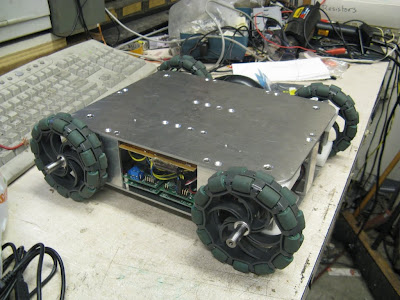So I set out to build one a while back. A small one. With no particular use for it in mind. It's so arbitrary that I couldn't decide on what size to make the main chassis, so I chose letter 8.5"x11". (But is it portrait or landscape?) Anyway, I got to the point where I saw that it would all go together nicely and then realized that I should probably finish my thesis and get through 2.007. All that was left was...well, all the electronics and programming... Now that it's summer, I have no excuse not to finish.
I thought the wiring would be hard, given the number of moving parts inside the Twitch sandwich, but it actually wasn't that bad. I converged on a clam-shell-like wiring layout: you lay all the interconnects from the top panel to the bottom panel along one edge. This allows easy assembly and disassembly without detaching wires.
Here's another view. The motor controllers are Pololu Trex modules, which I am very pleased with. The monster 1/4-scale servos are Vigor VS-11's. These are the servos we used for 2.007. They are ultra high-torque...like, over 1Nm. More than their equivalent Hitec servos. But as a consequence of that, they also draw a ton of current. Like, 2-3A each at full load. For that reason, I got a 7.5A BEC to power them. The only problem is, the microcontroller's LDO regulator is fed by the same 6V bus. And there isn't enough capacitance at the output of the BEC or in the servos to adequately decouple the switching. I found this out when Twitch started...well...twitching...under load.
Cue massive amounts of capacitance. 3300uF on the 6V bus, plus another 1000uF following the input diode on the line that feeds the microcontroller's LDO regulator.
Finally, it was time to close up the clam shell. Thanks to some serious Design For Assembly, I left myself an access hole so I could tighten the final servo horn screw with the clam all closed up. Unfortunately, I made the hole too small, so I still had to open everything, drill it out, and try again.
And that's that.. And this is the first test-drive:





What gear motors are those and what is that shaft assembly.
ReplyDeleteNice job /impressive
What method did you use to attach the Vex wheels to the Banebots motors?
ReplyDeleteI've been wanting to do the same thing but haven't seen a good way to do it until now
The gear motors are BaneBots 36mm planetary assemblies, 20:1, with the RS-385 motor.
ReplyDeleteThe shaft is 3/8" with a 1/8" keyway. I bored out the Vex wheel to the ID of its little hub. Very clear where to stop from the picture here:
http://www.vexrobotics.com/products/accessories/motion/276-2185.html
I made aluminum inserts that pressed into the hub and had the 3/8" bore and keyway. Probably overkill. You can kind-of see the idea in this view:
http://3.bp.blogspot.com/_bcej-id-XqQ/S-naDtzV3MI/AAAAAAAAAeU/bGZzYkpUPhc/s1600/twitch13.jpg
NEW SPORT: ROBOT DRIFTING
ReplyDeleteYour collection of toys is becoming frightening. That one, just may be the coolest.
ReplyDelete